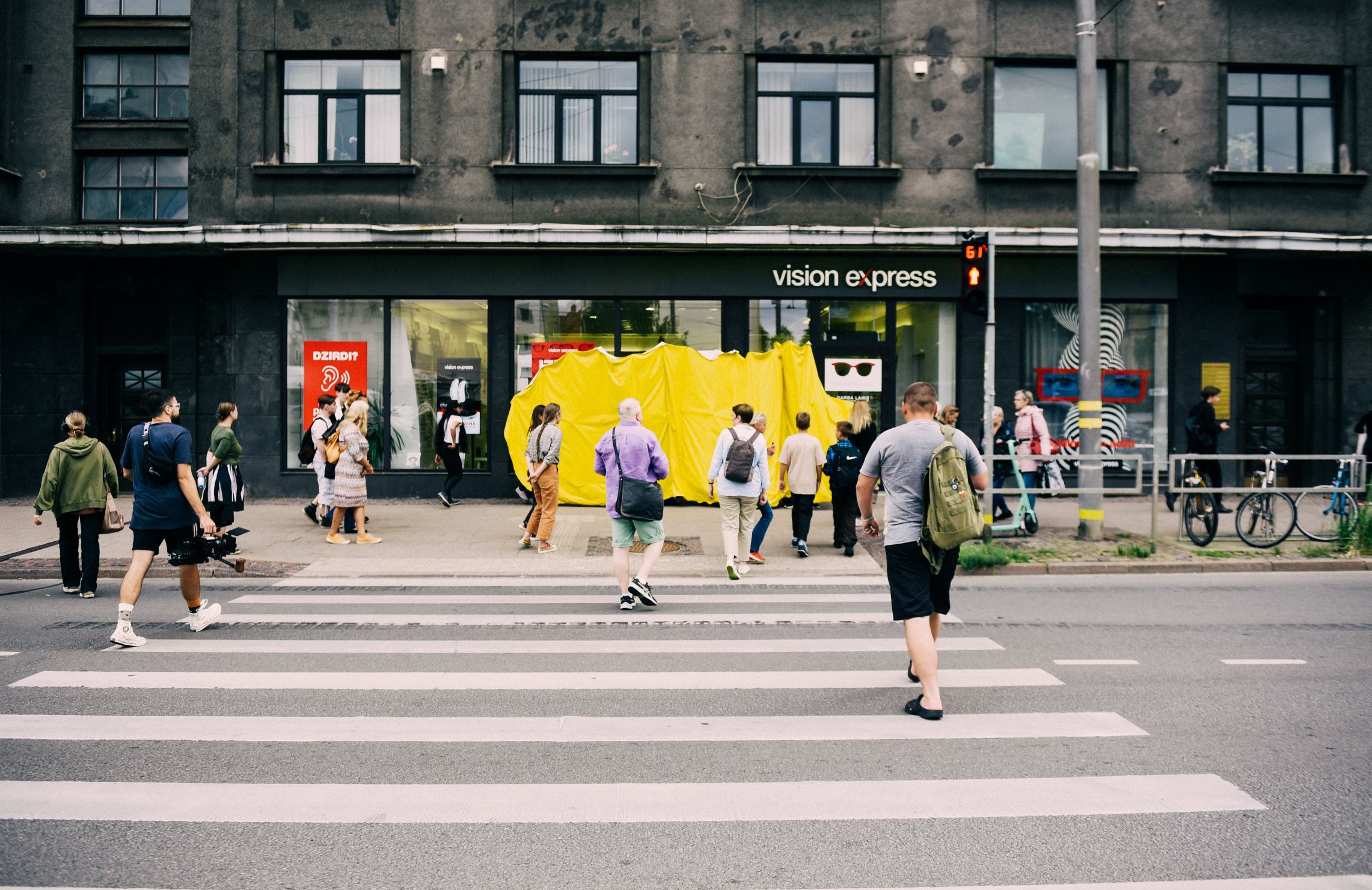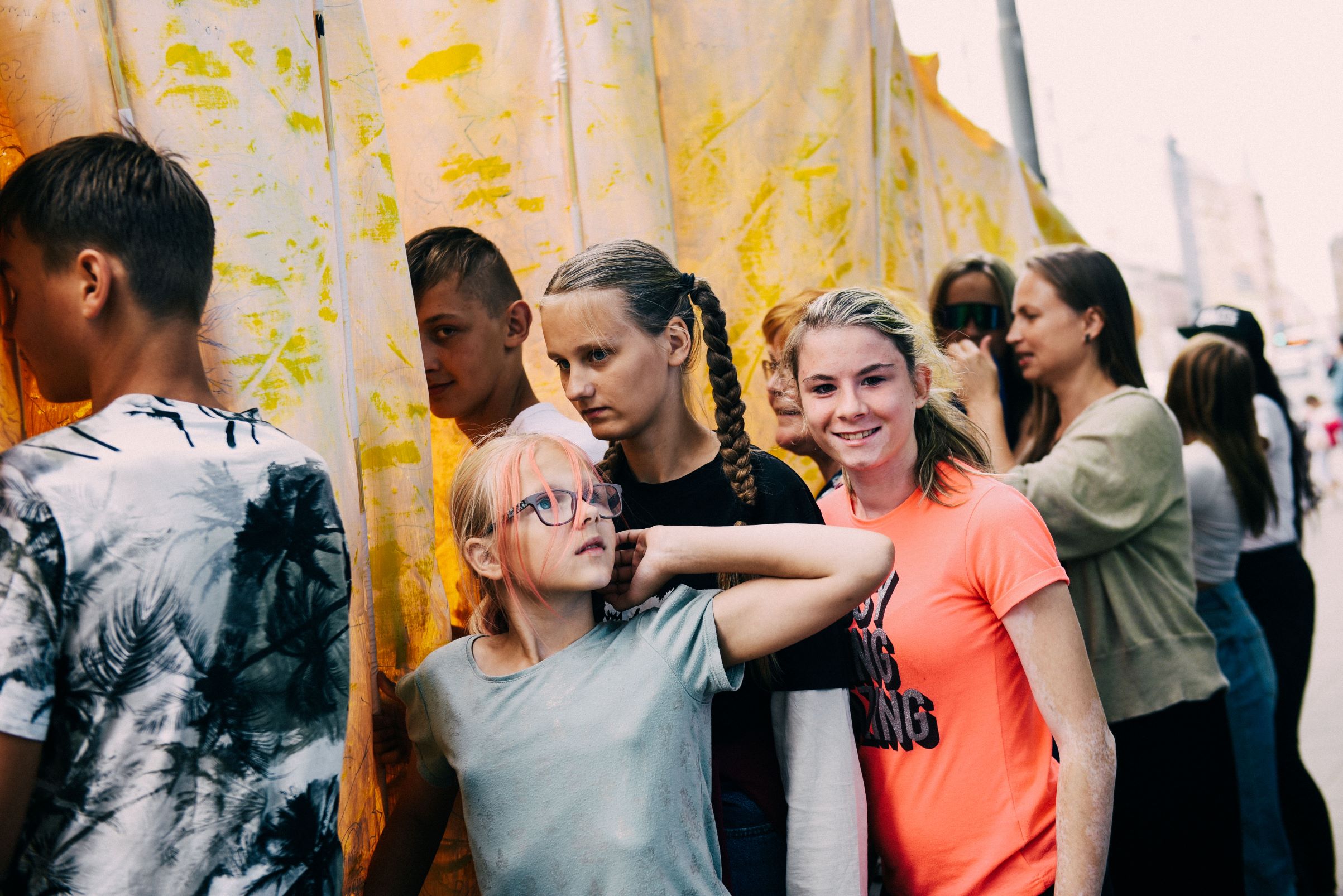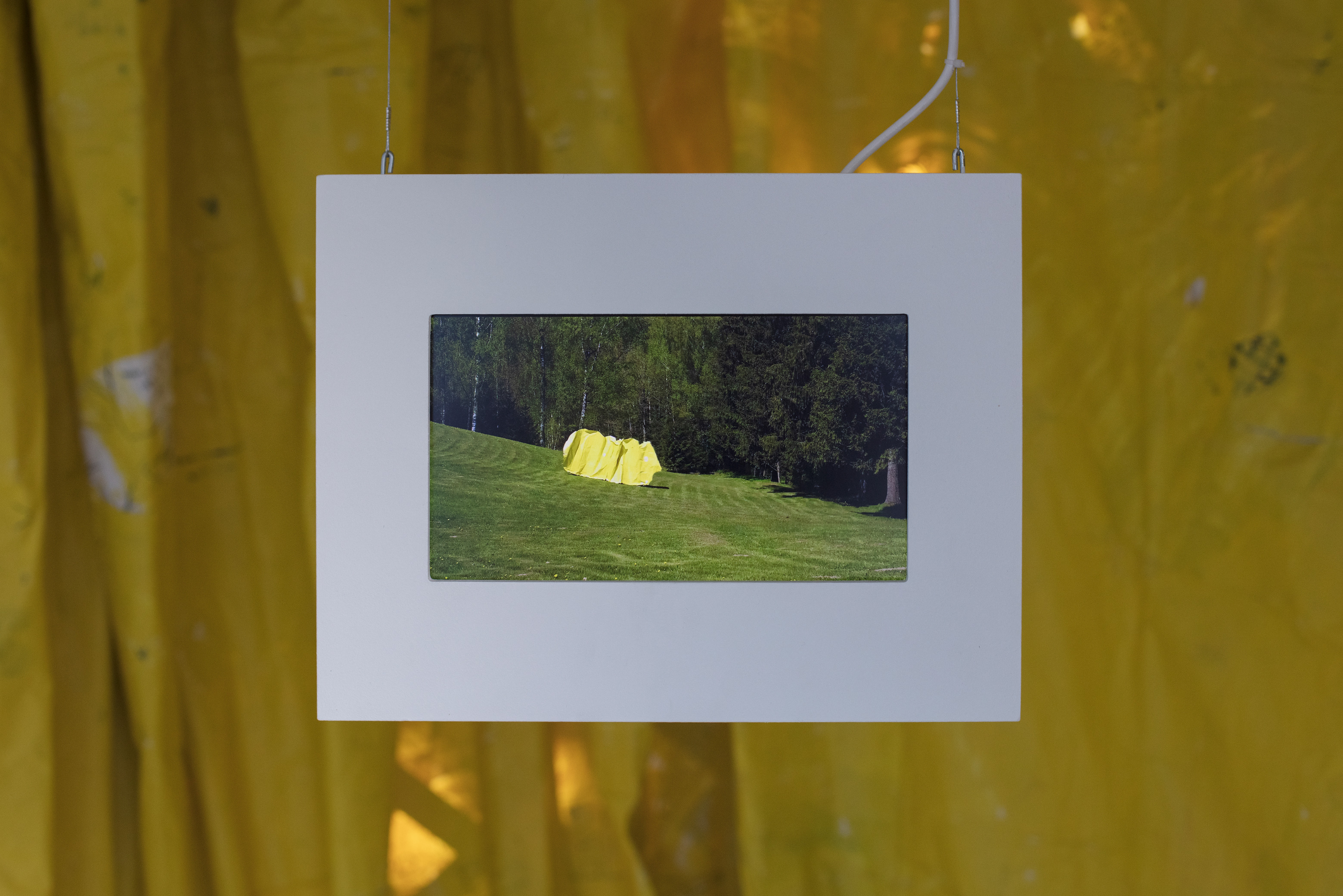May 31, 2024
“The Caterpillar’s Path” – Anda Lāce at Antūži Primary School

As part of the project, seven Latvian artists visited six schools throughout Latvia where they took part in art residencies with students.Read and get to know what Anda Lāce did in Antūži!
Who? The artist Anda Lāce and seventeen students of different ages
When? From February until May 2023, for 4 months, including staying at the school for 2 full weeks
Where? At Antūži Primary School
Other people involved? Music teacher Marita Vaivode and the art mediator Aija Putniņa
Watch here: Anda Lāce’s residency at Antūži Primary School
During the summer, we can meet caterpillars in a wide variety of places. For example, some of the most voracious creatures must be plucked off from the lettuce leaves which we had intended for our own lunch. Others, hanging on fine threads, glide right into our face when we walk under the linden trees. There are fat, white, patty-like larvae that we find in compost piles, and then there are skinny little ones that we find in wormy mushrooms. When stumbling through a field of nettles, you can bump into hedgehog-like, furry beauties, whereas on the forest trail we sometimes meet colourful giants covered in psychedelic patterns. In autumn, the caterpillars disappear – they pupate and turn into beetles, butterflies and other insects – we will never see them again or recognize them in their amusing caterpillar form, because everything becomes too serious. But then, after winter, the next late spring comes again, and they reappear once again in the most unlikely places.

The artist Anda Lāce chooses Antūži Primary School as the location of her residency in “The Artist Is Present” project. This is an educational institution for children with mental disabilities. Anda has visited here already before – in 2019, as part of the “Latvian School Bag” workshop organized by the Latvian Centre for Contemporary Art – and this time she is interested in the opportunity to meet with the students not only once, but to work with the same group of pupils for a long time. She wants to get to know the children through consecutive meetings, to understand each one’s best abilities and to gradually move towards a jointly created result – an artwork. For several years, Anda has been working as a curator at the Sansusī Well-being Residency Program, where she involves people with mental health disorders in the creative process.
Anda Lāce is an interdisciplinary artist who paints, does performances, creates objects and installations, and often collaborates with composers of contemporary academic music. In her art, Anda depicts various states of the human psyche and interacts with them herself. She and the viewer encounter repeated, nebulous characters stemming from the subconscious that carry across her performances and paintings.
During the introductory visit, Anda meets with the school management, which selects students of different ages to participate in “The Artist Is Present” residency according to their abilities to participate alongside others. From the beginning, she gets to know the institution’s pace and internal rules; afterwards she creates self-portraits with the students, talks about herself and the performance genre. Since the teenagers come from different grades, they also need to get to know each other and meet each other to become a united group.
The music teacher Marita Vaivode becomes an helpful active companion to Anda and the students in all activities of the residency. The artist also establishes a rule – that everyone who is present, both students and teachers, must participate in what is happening. There are no passive observers, there are only participants. To get to know each other better, the Antūži students, together with Anda, visited the Purvītis Prize and Amanda Ziemele exhibitions at the Latvian National Museum of Art. For several of them, it is their first time in Riga.

The ten classes of Anda’s residency take place during regular school days – during these sessions, the participants are excused from other classes, and the school management adapts to the artist by choosing dates that are most convenient for her. The group size is around ten students at a time, but it varies. There are students who attend one of the initial classes, then stop participating, but return later. In order to build mutual trust and get to know each other, Anda also meets her students also outside of the class – for example, they go for walks together near the boarding school.
As part of her residency, the artist has set three goals – introducing teenagers to contemporary art, creating an artwork for the exhibition “The Artist Is Present” in the fall, and improving the overall emotional well-being of the group. Contemporary art is a foreign concept to the vast majority of young people in Antūži. In light, multifaceted and playful ways, Anda introduces the students to this concept of art, emphasizing that contemporary art is, first of all, a way of thinking. Gradually, by performing small exercises using movement, sound and drawing, students get to know various ways of expression and methods in current art. As examples, Anda shares her own artworks and expounds on them by drawing on personal experience; through this, the students empathically find points of connection between themselves and art. The teenagers also imagine what kind of artists they themselves would like to be, and set up a temporary exhibition hall just like that in the gym. Even if the artwork does not fully materialize in the end, they try out what it means to have the image of an artist, and the opportunities of an artist.
In parallel to this, Anda observes the relationships within the group and wants to improve the emotional atmosphere using creative methods. At times, children are tense due to previous crises or a complex diagnosis of an illness, and it is difficult for them to smoothly take part in a collaborative work process. Therefore, each of the tasks that Anda provides has a unifying effect in its own way and questions the world of the student’s feelings. For example, the students review the emotions experienced during the day in the form of movement sketches, or collectively create a portrait of happiness covering the size of the entire gym. Everyone participates in what is happening within the scope of their abilities, and the artist tries to address everyone personally. In this “The Artist Is Present” residency, the process is more important than the result – living together and discovering one’s own abilities, as well as promoting the students’ independence. In her communication with the Antūži children and youths, Anda often makes use of the experience she has accumulated at the Sansusī Well-being Residency Program.

Around the fifth meeting, the artist and her team of students start thinking about their work for “The Artist Is Present” exhibition at the Vidzeme Market in Riga, which will be held as part of the festival Survival Kit 14. While playing together and developing different ideas, the image of a large caterpillar has traveled to them by chance, and Anda decides to make it the main character of this residency. Every child or teenager is often asked what they will become when they grow up – as if these first 18 years of life are just an introductory stage, subordinated to the serious “real” life. Such a superficial attitude saturated with the superiority of adults has a disparaging effect on the younger ones’ sense of self-worth. We are already here. The Caterpillar, whatever he later develops into – a butterfly, a beetle, a fish or another creature – is as valuable in this moment as any of its possible future forms. Anda Lāce has already previously developed these reflections in the performance “Cocoon” and in the series of paintings “Transformation Series Without Ending” (2013).
In this case, we must also address the other side of “The Artist Is Present” project. It is not only the collaboration of the artist with the students that is important, but also the artist’s expression as an author. In the collaborative creative process, the artist engages with the interests of children and youths, and, through the context of the specific place/time, also develops topics that are important to the artist herself in her own way. It is only in such a model of collaboration that it is possible to create an original and valuable artwork. The Caterpillar grows to be very big and round at Antuži Primary School. Its original version is made of paper attached to wooden sticks, so the Caterpillar resembles a giant Chinese shadow theatre figure. The students cut out the silhouette of the Caterpillar together, and fill it with their good thoughts in written form. Its head is filled with hopes for the future. The students then sustain these commitments by applying a thick layer of protective paint to the Caterpillar and to the texts. This bright yellow layer is applied using brushes attached to very long handles, requiring particular dexterity.
The Caterpillar is brought to life by making it move. Its job, as it befits a Caterpillar, is to be voracious and to eat all the bad things. On the last day of “The Artist Is Present” residency, a performance is held under the direction of the artist Anda Lāce, in which the students of younger classes also participate. The Caterpillar crawls down the hill to the thunderous sound of drums played by the younger students. It is led by students hidden behind the body of the big Caterpillar, counting the steps in a special rhythm. This amusing crawl-walk is caught on video.
The teacher Mairita Vaivode says the following about the benefits of “The Artist Is Present”: “It was valuable to follow the activities during the residency, to watch how the artist successively plans and implements the tasks. It was also an opportunity to get to know the school’s students better, to observe them in their work, as well as to develop their motivation to work in unusual situations.”
During the Valmiera Contemporary Art Camp, the Caterpillar is reborn in another body. The students of Antūži Primary School – Patrīcija, Kitija, Ieviņa, Ģirts and Aleksandrs – create it anew, using much more durable materials. Here, Ebba Moi, a member of the Norwegian artist collective Tenthaus, who has been supporting the project “The Artist Is Present” remotely throughout the project, joins the group. In the exhibition in Riga, the work of by the students of Antūži Primary School (Daniela Andžāne, Eva Andžāne, Krista Dāvida, Ņikita Gasparovičs, Kristiāns Jānis Gipters, Patrīcija Gudkova, Nikolajs Marcinkevičs, Ģirts Mežaks, Līga Baiba Osīte, Aleksandrs Pankratovs, Jānis Nikolass Šneiders, Niks Šneiders, Sergejs Voitka, Kitija Zariņa, Kristaps Zāle, Ieviņa Zeltiņa) and by the artist Anda Lāce, titled “Where the Caterpillar Crawls,” can be seen at the very end of the row of kiosks.

The small room is dusky – in front of the wide display window, in a box filled with soil, there is a lush jungle of leaves which would be good sustenance for a voracious creature. A screen inside shows the path of the caterpillar which began already in spring, but behind it, along the wall, there is the shed skin of its growing body. Anda Lāce says: “Our caterpillar is able to eat bad noises, incentives for war, toxic waste and to process them into valuable fertilizer or good gases that are useful in the farm, that can prevent violence, alcoholism. These are scenarios which we can develop further and continue. We reinforced all these good and fantastic thoughts using thick, yellow paint, because it seemed the strongest and the most suitable to use in early spring when we are yearning for the sun. And then the caterpillar began to crawl.” And indeed – during the opening of the exhibition, the yellow, giant Caterpillar crawls through the entire Vidzeme Market and goes into the streets of Riga.
Anda’s insights:
- Meeting outside of class time, for example, skating together, going on a hike or an excursion, or exercising on the sports field, can help improve communication, collaboration and understanding also during specific contemporary art workshops.
- If at first it seemed that 10 meetings are a lot, now there is a feeling that there could be more time. It seems like we would like some additional time for the kind of workshops which I have referred to as “introductory” before we start thinking more seriously about our collaborative artwork.
- I would like to more actively involve those students whose disorders and diseases have a stronger impact on their learning, working, collaborative abilities.
